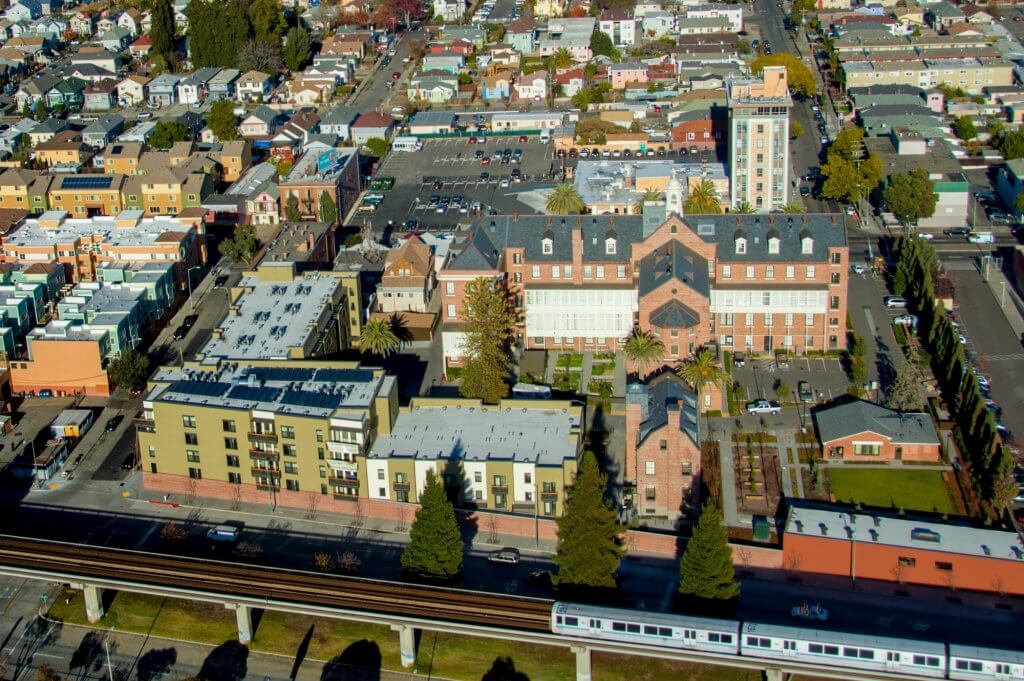Creating a Stronger Housing Element: The Example of Los Angeles
Published On August 3, 2021
In recent years, California has undertaken several unique strategies to better quantify housing needs at the local level and to encourage and require localities to plan for growth. The Housing Element, which requires cities to develop a blueprint for growth at the local level, is one such strategy. The Housing Element is a planning framework that requires all California cities to respond to state targets for expected household growth on an eight-year cycle. For many years, however, these documents have not been truly reflective of subsequent development realities on the ground. Cities may have a certified Housing Element on paper, without much likelihood that the growth specified in the Housing Element would occur, often because unrealistic sites were pegged for development or growth is cordoned off to just one part of a city. Legislators have passed a series of laws over a few years to strengthen the analysis that goes into Housing Element certification. These changes will require more rigorous analysis of how siting new housing is planned. This blog post shows how one city—Los Angeles—used data-driven evidence to justify their Housing Element sites, including original analysis conducted by the Terner Center. Evidence-based Housing Elements may better reflect development conditions on the ground, and may therefore force cities to reconsider their current land use practices in response to the housing goals set by the state.
Background
A quick primer on the California’s Housing Element process: the State of California’s Department of Housing and Community Development (HCD) assigns each metropolitan region an estimate of the number of units needed over the next 8 years to both meet existing housing needs and accommodate forecasted population growth. This process is known as the Regional Housing Needs Assessment, or RHNA. Each region then passes along allocations to the individual jurisdictions. Every 8 years, cities must demonstrate that they have adequate capacity of developable sites to meet their share of the regional target, and include this in an updated Housing Element, as required by law. As the draft deadline for the upcoming cycle grows nearer, cities are struggling to meet the new requirements enacted by recent laws.
Creating realistic Housing Element planning scenarios should now rely on objective estimates of future residential development. The state has adopted increasingly rigorous standards to produce these estimates. One key aspect is that cities may no longer assume that all the residential zoned capacity included in the Housing Element will actually be fully developed in the 8-year cycle. In 2017, AB 13971 amended the State Housing Element Law prompting HCD to call on cities to account for the probability of development of non-vacant sites. In the past, cities were allowed to assume that any parcel that had potential for development would be developed to its zoned capacity within the RHNA cycle with 100 percent certainty. Site capacity estimates were therefore often unrealistic.
More rigorous site standards resulting from AB 1397 have particular implications for California cities that are largely built-out and/or cannot annex or repurpose greenfield development. If those cities cannot justify that parcels with zoned capacity for additional residential use are likely to be developed, then they will be obligated to undertake zoning changes to produce the needed capacity. These upzonings or rezonings can be politically fraught, time-consuming, and expensive.
In addition to more rigorous site standards, recent reforms to the RHNA process included formula changes2 that better account for such factors as jobs-to-housing balance, worst-case housing needs, and overcrowding, all of which have been exacerbated by rising rents and home prices. As a result, the City of Los Angeles’ growth targets for the upcoming RHNA cycle have jumped markedly.
City of Los Angeles takes a new approach.
Recently, the City of Los Angeles released a draft Housing Element incorporating Terner Center Fellow Issi Romem’s estimates relating zoned capacity to future residential development. In collaboration with city staff, Romem developed a model to predict the likelihood and extent of future residential development for each parcel in the Housing Element. To our knowledge, Los Angeles is the first city to include a statistical site inventory analysis of past residential development in their Housing Element. These methods report site capacities grounded in empirical analysis rather than assumption.
In the last RHNA cycle, Los Angeles was obligated to identify capacity for 82,002 new units of housing. In the current cycle, Los Angeles is obligated to identify capacity for 456,643 new units of housing. This top-line increase in targets was a major source of concern to local elected officials when it was preliminarily allocated by the state in March 2021, with threat of possible litigation by cities that felt these new targets would be too hard to hit. Mayor Eric Garcetti, however, pushed the Southern California Association of Governments and the City’s staff to play a constructive role in the process.
“This is a moment of our growing up… I understand the fear where people are like: ‘No, just keep [housing] out and maybe my traffic won’t get worse.’ Well, we’ve tried that for three decades and it’s failed. This is a new beginning.”3
– Mayor Garcetti
Facing not only higher overall planning targets, but also a higher bar for estimating site capacities, Los Angeles partnered with the Terner Center to estimate realistic site capacity. As part of the 6th cycle of the Housing Element process, the City of Los Angeles provided HCD with a draft inventory of appropriately-zoned sites to demonstrate that it has adequate capacity to meet its growth targets.
Model Design
The approach taken to estimate realistic site capacity used recent residential development trends observed in the data as the basis for estimating future residential development. Specifically, it used data on permitting between 2015 and 2019 (5 years) to model the likelihood of new units being permitted on each Housing Element site, as well as the share of zoned capacity that would be developed over the next 5 years. The model accounted for parcels’ zoned capacity at the time with and without bonuses,4 as well as market conditions and other factors which the city is required to address by law under current requirements.
The model was then applied to current data—including changes over time of parcels’ zoned capacity, market conditions, and other factors—in order to predict the likelihood and extent of future residential development. Crucially, to comply with the requirements of existing Housing Element law (which doesn’t give cities credit for development beyond the bounds of the plans included in their approved Housing Element), the model was constrained so that the predicted number of units on a site could never exceed its capacity (inclusive of bonuses). That constraint is at odds with past development trends: about half of the housing units permitted in the city from 2015 to 2019 exceeded the observed zoned capacity, as a result of reforms to upzone the area during that time period.
Finally, the approach involved additional consideration of LA’s Transit-Oriented Communities (TOC) program, which significantly relaxed land use policy constraints near transit hubs starting in late 2017.5
Findings
The City of Los Angeles’ draft Housing Element marks the first large-scale move towards including data-driven statistical estimates of the likelihood and extent of future residential development in the Housing Element process.6 The research conducted is also informative in its own right.
The model predicts that, within the bonus-zoned cap, the parcels considered for the city’s Housing Element would see new units amounting to 6.5 percent (29,505 units) of its 456,643 unit allocation permitted within 5 years. Adjusting that number for an 8-year period, such as the RHNA cycle, raises the number to 10.3 percent (47,208 new units), and further adjusting it to account for the TOC program’s benefits brings the number to 13.4 percent (61,158 units).7
The likelihood of development of any individual site is low, and high-density multifamily sites are not always developed at full zoned capacity. From 2015 to 2019, about 1 in 80 parcels in the city saw new units permitted each year, which is a 5-year development probability of about 1.2 percent. For the upcoming RHNA cycle, the model predicts that the average parcel will have slightly better odds, with a 1.49 percent development probability over the next 5 years. Even for the most likely sites, the probability of development is fairly low, with the 99th percentile having an estimated development probability of just 8.58.
The vast majority of future new housing units are predicted to occur in multifamily housing, with the median unit being in a 12.4-unit development. If they are developed, sites zoned for 5 or more units are expected to see unit counts typically ranging from 40 to 90 percent of their bonus-zoned capacity, so it cannot be taken for granted that zoned capacity will be used in full. That said, a substantial share of units built in Los Angeles over from 2015 to 2019 occurred in excess of the observed zoned capacity, likely involving changes to entitlement.8
As a result, estimates of site capacity are far lower than they would have been otherwise. In fact, Los Angeles already has excess zoned capacity (i.e. zoned capacity above and beyond the existing number of units on a site) that amounts to multiple times its 456,643-unit RHNA allocation. In past cycles, the city could have applied screening criteria to select any arguably defensible subset of sites whose excess zoned capacity added up to 456,643 and met the RHNA allocation by asserting that all zoned capacity on the selected sites would be developed during the cycle, without any burden of proof. Accounting for the estimated likelihoods that sites’ existing zoned capacity will be developed during the cycle—instead of assuming that they will all be developed at full capacity with certainty—during this cycle means that the total estimated site capacity across the city is far lower than it would have been otherwise. The final figure of 44,832 new units over 8 years is less than 10 percent of the 456,643-unit RHNA allocation and so the remaining balance will need to be accounted for through a combination of new capacity from multifamily upzoning, the removal of other barriers to housing production, and complementary production strategies allowed by HCD to supplement the site analysis (such as Accessory Dwelling Unit and public land policies.)
Policy Implications
To our knowledge, no other California cities have undertaken as rigorous an assessment of the probability of development as the City of Los Angeles. Most cities rely on assumptions from planning staff on the likelihood of development. Such assumptions can easily reflect a “planner’s optimism” that development will inexorably flow from favorable zoning and adequately permissive land use regimes alone. While the Terner Center’s approach need not be the only viable method, an analysis with a comparable level of data-driven rigor is necessary for grounding zoned capacity estimates in development realities. To do otherwise would risk defeating the clear language now articulated in state law9 and ultimately undercut the ability of local governments and the state to understand the actual likelihood that planning targets will translate into new homes being built.
Yet, it may be a fraught proposition for this level of rigorous modeling to become the norm for the current Housing Element Cycle. Guidance from HCD, which has the administrative authority to clarify expectations for the Housing Element, has been largely non-prescriptive. This reflects the logistical challenge for California’s 540 cities and counties to identify and clean all the relevant parcel-level land use and permit data and run the relevant econometric models. Zoning reform and other regulatory changes that may prove to be necessary through the Housing Element process are also politically complex, and the non-prescriptive nature of HCD’s guidance may be accounting for the limited capacity of locally elected officials and city staff to adopt changes.
The rolling deadlines for Housing Element Adoption also mean that most California cities have already submitted their draft Housing Elements, creating a large hurdle for implementation if the state were to add new guidance on the Housing Element process. The Bay Area is the only major region that has yet to submit its draft Housing Element and creating a more exacting expectation for compliance at this stage would be criticized as arbitrarily impacting one portion of the state over others. A more nuanced approach may be necessary, such as HCD approval of cities’ 6th cycle Housing Elements conditional on them onboarding this level of analysis for a mid-cycle review four years out, or functionally pushing this provision of law back into the 7th cycle.
Regardless, investing in better collection and cleaning for parcel-level land use data is a critical next step for local governments, with the support of the state. This level of data collection is necessary for the kinds of analyses that would help local and state policymakers, researchers, and advocates to perform this level of analysis and, more broadly, to understand whether our state housing laws are effective or lag painfully behind. The state, working with and through the regional councils of government, must invest in creating and managing centralized, up-to-date, detailed parcel-level land use data for all California cities.
The sobering reality is that the City of LA can only expect about 0.2 percent of its sites to be redeveloped in any given year. It is a reminder that favorable zoning and land use regimes do not on their own create new housing. Indeed, upzoning, for all its coverage and debate in recent years, is necessary but insufficient on its own for solving the twin challenges of financial feasibility and finite capacity within the housing industry. Building housing in California has become significantly more time-consuming and expensive than it historically was compared to peer regions around the country.10 This is true when building on an empty site but even more so when redeveloping a site with an existing building. Expanding the housing stock in California’s large metro areas will require addressing both challenges: restrictive land use policy and the high costs of building that housing.
End notes
1. See Section 65583.2 (g) (1) For [relevant sites], the city or county shall specify the additional development potential for each site within the planning period and shall provide an explanation of the methodology used to determine the development potential.
2. These new requirements are part of a wave of recent legislation passed to address long standing criticisms to California’s Housing Element Law. For a more detailed dive into criticism on the law itself, RHNA, and how cities estimate site capacity, see the following sources:
- Ling, S. (2019). “How Fair Is Fair-Share? A Longitudinal Assessment of California’s Housing Element Law.” UCLA. https://escholarship.org/uc/item/45g2k3fp.
- Monkkonen, P., Manville, M., & Friedman, S. (2019). “A Flawed Law: Reforming California’s Housing Element.” https://escholarship.org/uc/item/6dx7914m#main.
- Bromfield, H. & Moore, E. (2017). “Unfair Shares: Racial Disparities and the Regional Housing Needs Allocation Process in the Bay Area.” https://escholarship.org/uc/item/7nx462rf.
- Howle, E. M. (2020). “The State Must Overhaul Its Approach to Affordable Housing Development to Help Relieve Millions of Californians’ Burdensome Housing Costs.” California State Auditor Report, p. 78. Retrieved from: https://www.auditor.ca.gov/reports/2020-108/summary.html.
- Lewis, P. G. (2003). “California’s Housing Element Law: The Issue of Local Noncompliance.” San Francisco: Public Policy Institute Of California. Retrieved from: https://www.ppic.org/content/pubs/report/R_203PLR.pdf.
3. Dillion, L. (2019). “Coastal cities give in to growth. Southern California favors less housing in Inland Empire.” Los Angeles Times. Retrieved from: https://www.latimes.com/california/story/2019-11-07/housing-building-density-zoning-coastal-inland-empire-southern-california-scag.
4. Bonuses can be applied in different ways, e.g. depending on the share of subsidized units and their rent level, so rather than there being a single number that reflects allowed capacity with bonuses there is in reality a menu of such numbers. The numbers provided here were provided by city staff and reflect the city staff’s assumptions as to which bonus structure to apply to each parcel, based on eligibility for a range of affordable housing incentive programs (including Density Bonus, TOC, and Community Plan Implementation Overlay Zones).
5. A full rendition of the model’s methodology, its relation to the legal requirements and its predictive performance is provided in Section 4 of Appendix 4.6 of Los Angeles’ draft Housing Element, and the treatment of the TOC program is provided in Section 5 thereof.
6. For an extensive review of the implications of recently passed legislation on HCD’s power to enforce and reform the Housing Element process, including noncompliance issues for cities unable to meet RNHA goals, look to Chris Elmendorf’s legal review.
7. City staff subsequently tempered that figure down by manually removing sites whose existing uses would likely preclude development in ways unaccounted for by the model, yielding a final figure of 44,832, or 9.8 percent, of the city’s allocation.
8. As already noted, in order to comply with the requirements of existing Housing Element law (which doesn’t give cities credit for development beyond the bounds of the plans included in their approved Housing Element), the model was constrained so that the predicted number of units on a site could never exceed its capacity (inclusive of bonuses).
9. See above, AB 1397.
10. Raetz, H., Forscher, T., Kneebone, E., & Reid, C. (2020). “The Hard Costs of Construction: Recent Trends in Labor and Materials Costs for Apartment Buildings in California.” Terner Center for Housing Innovation. https://ternercenter.berkeley.edu/hard-construction-costs-apartments-california; Reid, C., Napolitano, A., & Stambuk-Torres, B.(2020). “The Costs of Affordable Housing Production: Insights from California’s 9 Percent Low-Income Housing Tax Credit Program.” Terner Center for Housing Innovation at UC Berkeley. Retrieved from:https://ternercenter.berkeley.edu/development-costs-LIHTC-9-percent-california; Reid, C. & Raetz, H. (2018). “Perspectives: Practitioners Weigh in on Drivers of Rising Housing Construction Costs in San Francisco.” Terner Center for Housing Innovation at UC Berkeley. Retrieved from: https://ternercenter.berkeley.edu/uploads/San_Francisco_Construction_Cost_Brief_-_Terner_Center_January_2018.





